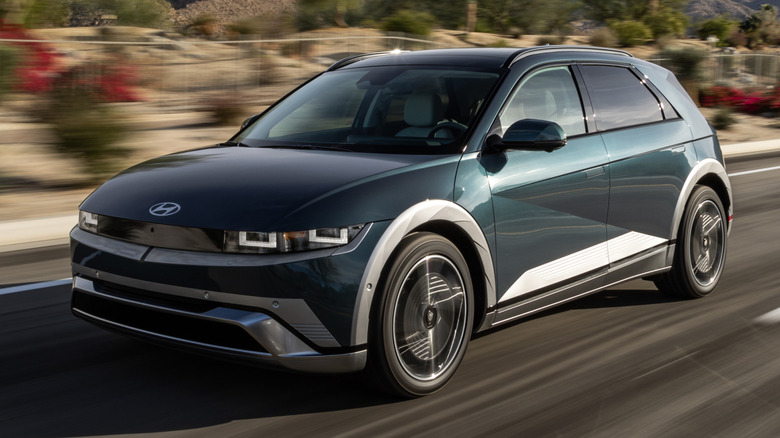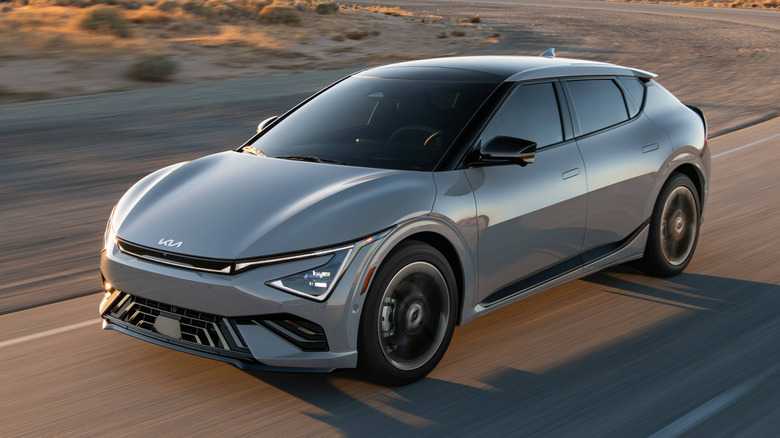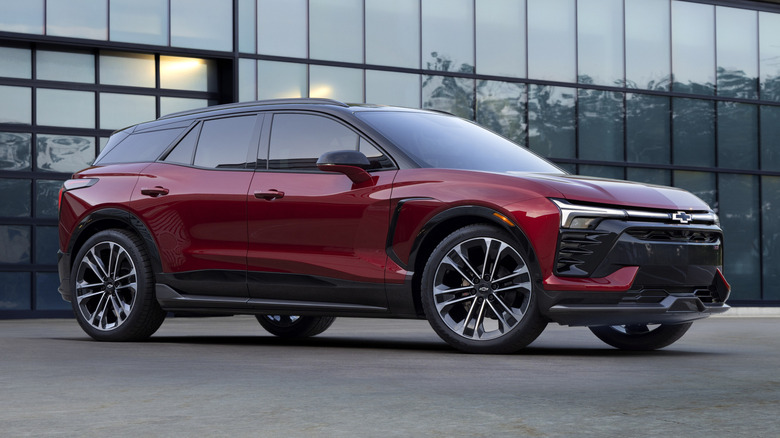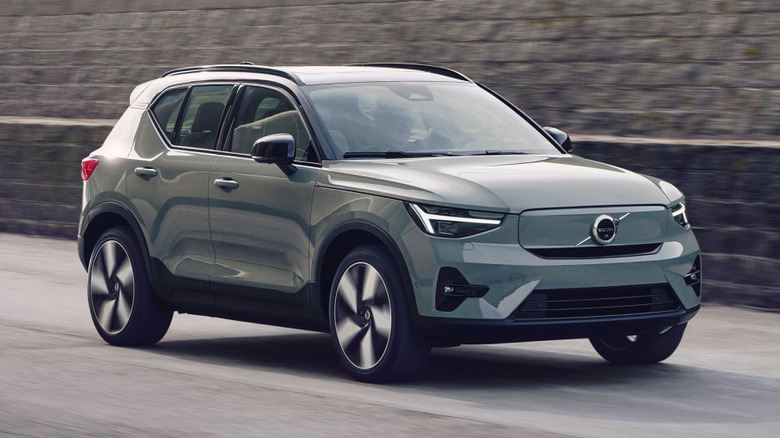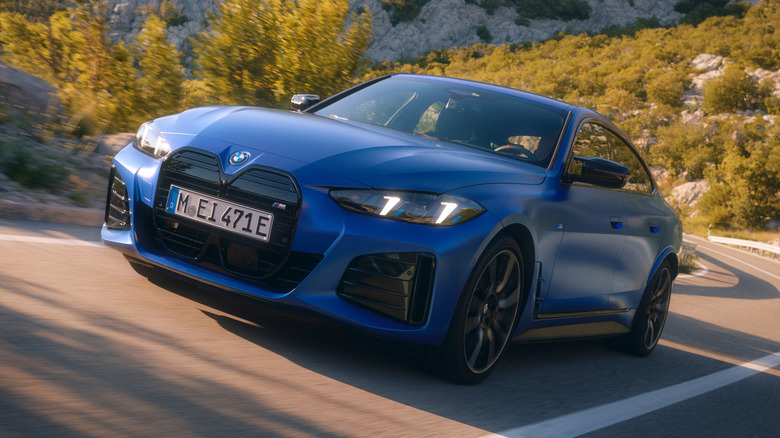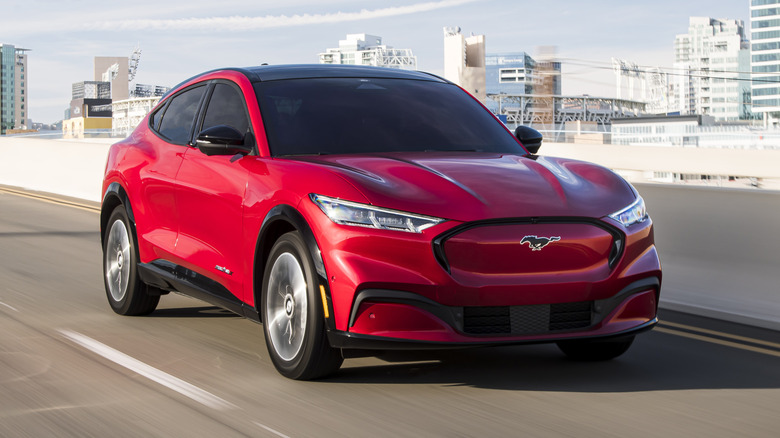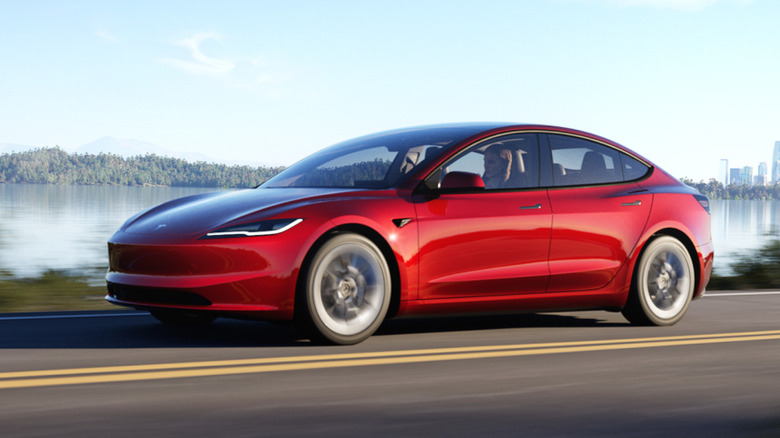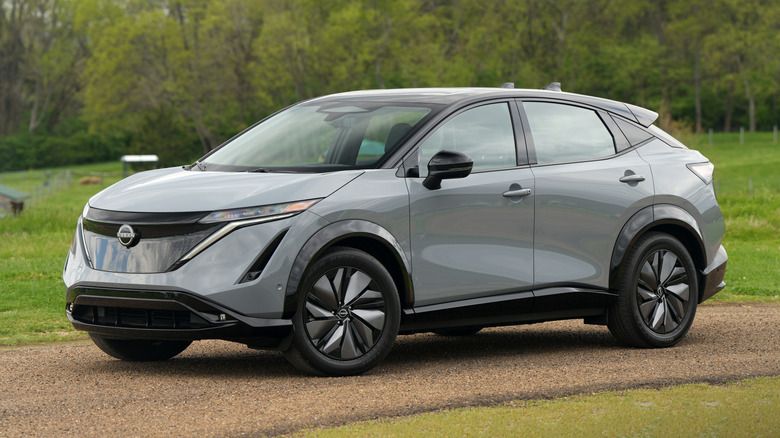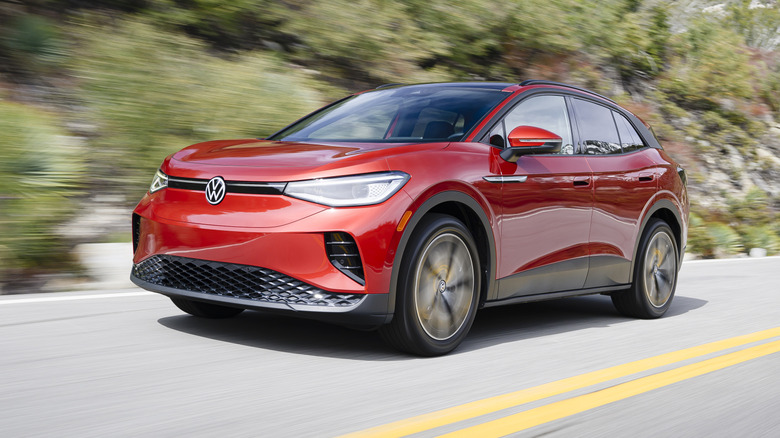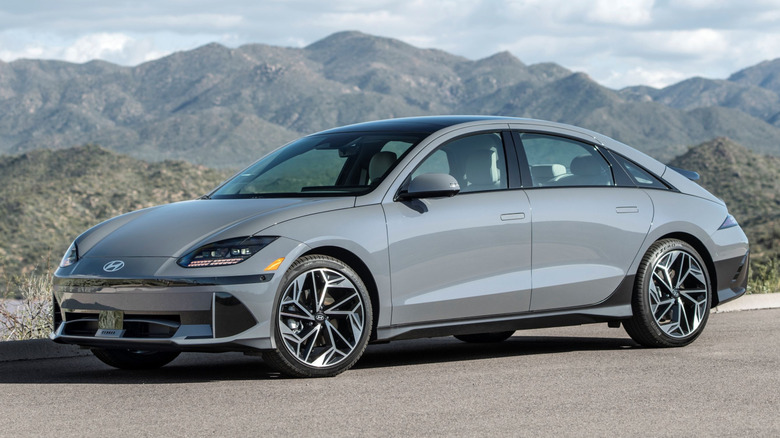10 Alternatives To The Hyundai Ioniq 5
Look around at the rapidly evolving EV market and it can feel like it's impossible to keep up with the latest releases. It seems like every month, another major manufacturer announces a new model or unveils its plans for the future, promising more range, more power, and more tech to outgun its ever-changing field of rivals. In that context, the Hyundai Ioniq 5 is far from being the new kid on the block, having been on the market since the 2022 model year. Still its looks, capabilities, and pricing keep it an attractive option, with the 2025 Ioniq 5 starting from $42,600.
From there, the Ioniq 5 rises in price across five trims, with each one adding either range, power, additional features, or a mix of all three. The Ioniq 5 N, with its 601 horsepower output and track-ready performance tires, is marketed separately, and starts from $66,200. No matter which end of the Ioniq 5 trim range you're looking at, there are plenty of rivals available both from other manufacturers and even from Hyundai itself.
We've rounded up 10 particularly competitive picks, all of which are worth considering before you head to a dealership to pick up a new Ioniq 5. We've included current price data for each, with all prices listed excluding fees unless otherwise specified.
Kia EV6
Kia has given its EV6 a range of upgrades for the 2025 model year, with more power on offer in lower trims and a higher range, too. Exact figures vary depending on which battery option buyers pick, but expect 300 miles or so of range and at least 167 horsepower. In top-spec form, the EV6 GT produces over 600 horsepower, making it a true performance EV in line with the Ioniq 5 N. Prices for the EV6 range are also roughly in line with the Ioniq 5, and this similarity is no mere accident.
Both vehicles share a common platform and battery pack, plus the same optional all-wheel drive system. The main differences revolve around each car's cabin, options list, and styling — the last of which makes the EV6 an appealing alternative. The styling of the Ioniq 5 is very much a love-it-or-hate-it affair, with a kind of space-age hatchback vibe unlike anything else on the road. The Kia, in comparison, offers a look that's more in line with the rest of its maker's lineup, and doesn't immediately stand out as an EV. For some people, that alone might be enough to tip the balance towards the Kia.
Chevrolet Blazer EV
The Ioniq 5's hatchback appearance is unique and is a departure from the typical SUV and crossover styling that buyers can't seem to get enough of in today's market. Anyone on the hunt for an EV that looks less distinctive could consider the Chevrolet Blazer EV, which sports very similar styling to Chevy's gas-powered SUV range. Much like the Kia EV6, the Blazer EV's nondescript looks might make it more appealing to certain buyers, particularly anyone who's looking to switch to an EV for the first time and wants something that looks familiar in their driveway. As well as looking familiar on the outside, the interior of the Blazer EV should feel familiar to anyone who has owned a recent Chevrolet SUV, unlike the retro-modern cabin of the Ioniq 5.
The Blazer EV offers a similar range to the Ioniq 5, with 279 miles of range available for all-wheel drive models and up to 324 miles of range available for rear-drive cars. The Chevy is more expensive than the Hyundai, with the base-spec car costing $54,200 or $48,670 after deductions, such as EV bonus cash.
Volvo EX40
For 2025, the former XC40 Recharge has been renamed as the EX40. It's still the emissions-free counterpart to the XC40, albeit with a slightly higher price tag as a result of its battery pack. The base-spec EX40 starts from $53,795, and so is on par with the Ioniq 5's Limited trim, which starts from $54,300 for 2025. The Volvo's standard single-motor powertrain offers 248 horsepower and up to 296 miles of range, and a dual-motor option is also available as a $1,750 option. Adding the extra motor brings the EX40's range down to 260 miles, a notable drop compared to the Hyundai, but it compensates for that with a healthy 400 horsepower on tap.
Volvo is known for its premium but understated cabins, and the EX40 builds on that by offering a generous list of tech as standard. A wireless phone charging pad, a 12.3-inch driver display, and a 9.0-inch infotainment touchscreen are available across all trims, with that infotainment system running the same Android-based OS found in other Volvo models. As a bonus, the Volvo badge arguably offers more brand prestige than the Hyundai, although if prestige is your primary concern, there are plenty of other alternatives available.
BMW i4
Rightly or wrongly, the BMW badge still justifies a higher price than its less-prestigious competitors in the minds of many buyers. However, the i4 would be solid value at its price point even if it didn't sport that badge, with sporty driving dynamics, a practical but luxurious cabin, and plenty of onboard tech. At the top of the range sits the well-reviewed 536 horsepower i4 M50, but that will be out of budget for most Ioniq 5 buyers. On the other end of the range, the base-spec i4 eDrive40 might be worth considering, as its starting price of $57,900 is only a few thousand dollars pricier than a fully-loaded Ioniq 5.
BMW claims that the base i4 has an estimated range of 295 to 318 miles, and can sprint from 0-60 mph in 5.5 seconds. Opting for the all-wheel drive i4 xDrive40 pushes the car's starting MSRP up to $62,300 and decreases the range to between 268 and 287 miles, but it does shave a few tenths off the 0-60 mph time. Unless you live in an area where all-wheel drive is a necessity, the rear-drive sedan is arguably the better value for money.
Ford Mustang Mach-E
Look past the controversial name and you'll find reasons to like the Ford Mustang Mach-E. It is a capable, family-friendly EV, and in its base-spec form, the Mach-E is marginally cheaper than the Ioniq 5. Much like the Hyundai, Ford offers the car in a range of flavors, from the value-driven Mustang Mach-E Select to the range-topping Mustang Mach-E Rally. The latter adds extra power, MagneRide suspension, and rally-inspired wheels to the car, but comes with some caveats. It costs at least $58,995 excluding fees, and its range drops to an unimpressive 265 miles.
Lower trims of the Mustang Mach-E fare better with regards to range, although they're still a way off the best in class. The Premium trim has the longest range of the bunch, with an EPA-estimated 320 miles on offer, while the Select and GT trims offer 300 miles and 280 miles, respectively. Those numbers are broadly competitive with the Ioniq 5's range, which offers between 245 miles and 318 miles depending upon trim.
Tesla Model 3
If you don't mind the increasing amount of baggage that comes with owning a Tesla, the brand's entry-level model is still an appealing alternative to the Hyundai Ioniq 5. As of writing, the base Long Range All-Wheel Drive variant starts at $42,490, while adding all-wheel drive increases that price to $47,490. The top-spec Performance All-Wheel Drive starts at $54,990. Tesla is known to frequently change its pricing, so those figures are subject to change.
The cheapest version can go the longest between charges, with 363 miles of range on offer, while the performance variant should deliver a still-impressive 298 miles. Of course, the Model 3's capabilities will already be well known to the vast majority of EV buyers, and whether the Tesla is a viable alternative to the Ioniq 5 or any other EV is no longer simply a question of capability. The brand's cars are increasingly overshadowed by the actions of its CEO, and in the immediate future, that seems unlikely to change.
Nissan Ariya
It isn't the most unique, interesting, or even the most capable EV in its price bracket, but that doesn't mean that buyers shouldn't consider the Nissan Ariya, which we gave 7/10. In fact, they might want one precisely because of those qualities. The Ariya doesn't look particularly unusual in today's sea of crossovers and SUVs, and its minimalist interior is hardly unique for an EV, either. It starts around $40,000, but the premium Platinum+ trim will cost at least $54,370. All-wheel drive is available across all trims, but in lower-spec models, front-wheel drive is standard.
Range varies between trims, with the Platinum+ trim offering 267 miles on a full charge. That's hardly revolutionary, but it's more than certain variants of the Ioniq 5. We found the Ariya to be on the dull side to drive, but then let's face it, most EV crossover buyers aren't likely to be all that fussed about driving dynamics. They'll most likely want a reasonably spacious, reasonably capable, reasonably priced, and reasonably unremarkable car, and the Ariya is exactly that.
VW ID.4
Another slightly unremarkable but potentially appealing alternative to the quirky Hyundai is the VW ID.4, which starts at around $40,000 in base-spec form. The top-spec ID.4 AWD Pro S, which adds extras like leatherette upholstery and 12-way power adjustable seats with a massage function, costs from $53,875.
Reviewing the car at the start of the current generation, we gave the ID.4 an 8/10 rating, praising its ride and interior space but finding its range to be a little underwhelming. In the two years since then, VW has upped the range figures for its ID.4 trims, with 291 miles now available from the most capable variants.
That's still slightly short of the best-performing Ioniq 5 variant, but should be plenty for most drivers looking for an urban or suburban commuter. In other areas, we thought the ID.4 was typical VW fare, but in a good way, as it meant that existing VW owners should feel at home even if they haven't owned an EV before.
Hyundai Ioniq 6
As well as looking at its competition from other brands, it's worth looking within Hyundai's range for rivals to the Ioniq 5. Its closest rival is the Ioniq 6, a blend of style and substance which looks a lot sleeker than its hatchback stablemate and starts cheaper, too. It's available from $38,750, with the base-spec variant packing 149 horsepower and up to 240 miles range on a single charge. The power output is modest in EV terms and it is arguably better value to step up to the SE trim, which starts from $42,800 and offers up to 342 miles of range in rear-wheel drive configuration. Adding all-wheel drive with the dual-motor setup decreases range slightly to 316 miles but boosts power considerably to 320 horsepower. The rear-drive SE is no slouch though, with 225 horsepower on offer.
The SEL and top-spec Limited trims both add desirable extras and a plusher cabin, but bring no extra power and a slight decrease in range compared to the SE. We spent some time with the Ioniq 6 at its launch and noted a few downsides, most notably the car's reduced rear headroom thanks to its sloping roof. In N form, the Ioniq 5 is also still the clear choice of the two for drivers looking for performance. However, those caveats don't distract from the fact that the Ioniq 6 is impressive value for money in SE trim.
Toyota GR Corolla
It's safe to say that most Ioniq 5 buyers will be looking for a sensible, reasonably priced EV, and all the other picks on this list reflect that brief. However, those considering the Ioniq 5 N will likely have a very different agenda. They'll want maximum driving fun for their cash, and for that, it's worth considering whether an EV is the right choice.
The Ioniq 5 N is certainly an impressive car and is far more engaging to drive than virtually all other EVs at its price point, but it can't quite match the thrills of the best performance hatchbacks on the market. In particular, it's no match for the world-class Toyota GR Corolla, which doesn't need outrageous horsepower figures or fake gear shifts to be fun to drive. It's built using Toyota's extensive rallying expertise and is just as at home carving up backroads as it is on the track. Also, as our 10/10 review pointed out, the Corolla is available with a manual transmission.
Of course, the GR Corolla's punchy three-cylinder engine isn't emissions-free like the Ioniq 5 N, but other than that there's little reason to pick the Hyundai. Electrification is arguably a mixed blessing for enthusiasts, as increasing demand has meant that Hyundai can now justify making fun-to-drive EVs like the Ioniq 5 N in the first place. However, this means cars like the GR Corolla are becoming a dying breed. While it's still available, enthusiasts shouldn't miss the opportunity to own one.
